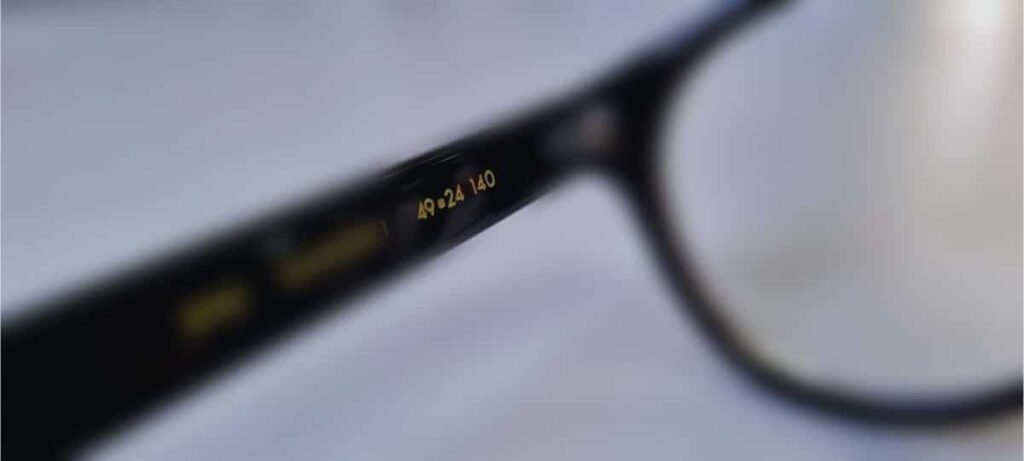To ensure perfect vision, when choosing eyeglasses and sunglasses (normal or prescription) you need to pay particular attention to the measurements of your face.
We have already talked about the aesthetic impact of frames on the shape of the face; oggi invece today, however, we will focus on objective data, that is, on the distances of certain reference points such as the nose and eyes . The reason is easy to say: the foci of the lenses must be perfectly aligned with the pupils, to allow the visual support to function as per the manual.
The concept is not dissimilar for sunglasses, although not graduated: having to accompany the gaze without creating shadow areas or visual distortions, they must be chosen taking into consideration the uniqueness of one’s face.
Why is glasses size important?
There is nothing worse than wearing a frame that doesn’t fit properly: you will start to “feel” it where it slips or tightens; you will notice it for example while going down the stairs, looking downwards; redness and friction will be created on the skin; you will be inclined to constantly touch your glasses to adjust them and to try to see better.
These are just some of the inconveniences that can occur, however the main one is that perfect vision will be lost, also risking worsening the initial situation. For this reason, it is essential to understand which size is right for us and choose accordingly.
How to read glasses measurements

First of all, it is good to know that inside the temples it is possible to find out what the size of a specific frame is: you will in fact notice three numbers. These, just like clothing items, can give us various indications:
- the first number refers to the width of the lens, i.e. the diameter taken horizontally, called ” caliber “;
- the second is the width of the bridge, i.e. the part that connects one lens to another and rests on the nose.
- the third is the length of the stems.
It therefore goes from a Small, then a Medium and ending up with a Large. For example, a Small pair of glasses could have numbers 50 – 23 – 145 superimposed on the temples.
How to measure your face size for glasses

So how do you proceed with choosing the right size? If you already have glasses that are well suited to the shape and distance of your face, everything will be very simple: just ask the optical shop for a frame bearing the same numbers.
If, however, it is your first pair of glasses, then you will also proceed to measure independently and in a really easy way. All you need to do is get a credit card and use it as a reference parameter: let’s stand in front of a mirror and get started.
1. Measure the width of your face
You will need to place the credit card vertically under your eye , resting the long side on your nose. Now let’s look: where does the short side end?
- If it ends beyond the eye (outwards), then you will have to opt for glasses measuring Small , therefore approximately with a caliber within 50mm.
- If the size of the paper is perfectly equal to that of the width of the eye, the Medium will be indicated (maximum caliber of 53mm)
- If the short edge ends before the eye, then you will need a size Large (gauge over 53mm).
You can also ascertain the width between the nose and the end of the eye with a ruler, noting the measurement exactly in millimetres.
2. Measure the distance between your eyes
If, however, you want to know the interpupillary distance, you will need to position yourself in front of the mirror, placing the ruler in front of your eyes, aligned with your eyebrows. You will need to proceed with one eye at a time, then closing the right one first and checking that the zero is in the center of the left pupil. Reopening the right eye, you will have to see which millimeter mark ends exactly in the center of the right pupil.
This is a delicate operation which is more reliable if carried out with the help of another person or your trusted optician. In this case, when carrying out the measurement you will have to look above the head of the person in front of you.
3. Measure the length of the rods
This data should actually be taken by directly testing the preferred glasses; the rod must be long enough to reach behind the ear, usually ending with a rounded shape, so as to “hug” it.
However, it must not be too long, otherwise the frame would slide forward, failing to “hook” correctly to the back of the auricle.
CliC glasses adaptable to all sizes
There is a versatile solution that adapts to all sizes: it is the Tube collection by CliC. Its peculiarity is the provision of a headband made of soft material which can be narrowed or lengthened. In this way, reading glasses or sports sunglasses wrap around the head, whatever size they are: extensibility is guaranteed beyond 10 centimeters per side.
The tube of course is always a safe solution thanks to its composition of acetate polymers and 20% TR90: extreme flexibility, combined with strength and resistance.
Thus, millimetre measurement will no longer be a problem.

